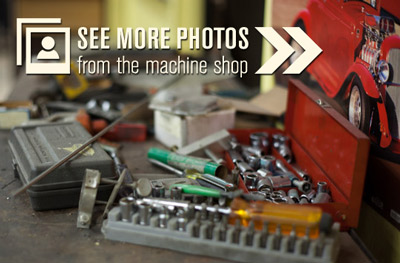UC Santa Cruz glaciologist Slawek Tulaczyk wound through the dimly lit hallways in the basement of the Baskin Engineering Building, carrying sketches for an idea in his hand.
He needed a probe that would survive minus-40-degree temperatures and be able to drop a half-mile through a 12-inch hole in the Antarctic ice and imbed itself in the sediment of a mysterious, subglacial lake. Tulaczyk knew information he gathered from that buried body of water might answer important questions about global warming or what kind of life could exist in icy worlds in other parts of the solar system.
But how to build the device?
That's where a pair of self-described "old-school" UCSC machinists named Dave Thayer and Joe Cox came in. Brainstorming with Tulaczyk, drawing plans on old-fashioned graph paper, the pair not only handcrafted the weighted, stainless-steel probe in their shop but also built a winch equipped with double-caliper 1992 Ford disc brakes that would lower the equipment through the ice.
"Dave and Joe turned these designs into beautiful, shiny instruments that have the functionality and robustness that we need to be able to take scientific samples and make measurements in the most remote and harsh environment on Earth," Tulaczyk said.
He was just sorry, he added, that the two 63-year-old machinists who run UCSC's Physical and Biological Sciences Machine Shop weren't there to see their work disappear down a borehole in the middle of a desolate ice sheet.
The P.B. Sci. Machine Shop lies amid a claustrophobic warren of labs and storage rooms. It's here that Thayer and Cox reign over rows of milling machines, lathes, and welding equipment — where the scientific rubber meets the road.
Every year, Thayer and Cox turn out about 120 completed jobs. With KPIG playing in the background, they undertake projects as complex as constructing watertight housing for elephant-seal tracking devices and fixing an unruly robotic arm to those as simple as fashioning mounting brackets for computer equipment.
They are born tinkerers who combine the skills of a machinist with the creative brains of engineers and troubleshooters. They attended junior college but it doesn't take long to figure out they have doctorates in experience.
Watch them work a lathe and they're Michelangelos with metal. Ask them to mill 24 holes into a stainless steel plate and each one will be within 10,000th of an inch of the other.
Thayer, who drives a 1936 Dodge panel truck to work every day, smiled as he described scientists coming into the lab with this greeting: "Hey Dave, I've got an idea."
It's all they need to get started.
The two men have a computer tucked away in the workroom but don't use it like most modern-day machine shops, they said. They question their clients, brainstorm, draw out ideas with paper and pencil, make models, troubleshoot — and haven't yet met a problem they couldn't solve.
"At other machine shops you can't walk in with a sketch on a napkin because they don't know how to do it old-school," said Cox with a grin.
The two dug out photos of their projects like parents showing off Little League pictures. There are shots of a squeeze chute Thayer built to humanely hold elephant seals while researchers draw blood and examine the animals. There are photos of a large, spider-like device that was used to simulate conditions around the rim of an active volcano.
Thayer located a sheet of paper with handwritten instructions for the simulation project.
"Design and fabricate a motor-controlled simulator that is able to control heating, stirring, introduction of CO2 into sample vessels, introduction of precise amounts of liquid into sample vessels, and mounted in a fully enclosed, polycarbonate chamber," it read.
But what it meant was that, working with David Deamer, a research professor of biomolecular engineering at UCSC, Thayer fashioned a one-of-a-kind simulator designed to test the kinds of conditions where life might have begun. The simulator alternately watered and dried samples as would happen at the edge of hot-water pools on volcanic sites. It was Thayer's idea to rotate an aluminum disk over heaters in the drying process, according to Deamer, who has presented the unique simulator in numerous talks.
"Dave has this talent for taking rough sketches of ideas and turning them into what amounts to a work of art," Deamer said.
It's not only scientists and grad students who wander into the machine shop for help. The two men talked of undergraduates who came in needing advice for their senior projects, including construction of a boxing robot and a space elevator. Once a year, the two men also lead an intensive three-week class that teaches students the basics of milling and using a lathe.
Most importantly, Thayer said, in 18 years there's never been an accident.
The shop brings in about $10,000 a month and has garnered Thayer and Cox recognition on published research papers, but the pair doesn't work for the glory.
"I like the work because it's challenging," Cox said, "and it feels like you're contributing something to society and to the university."



